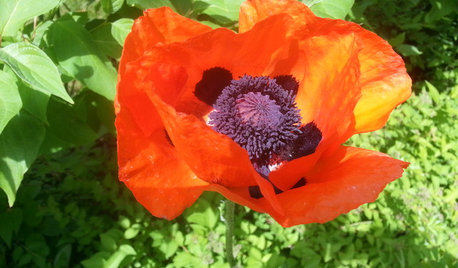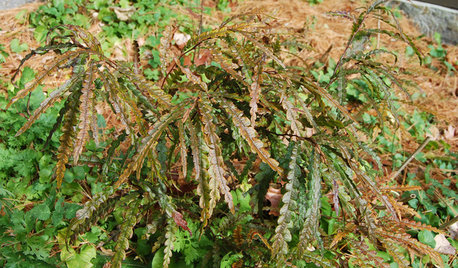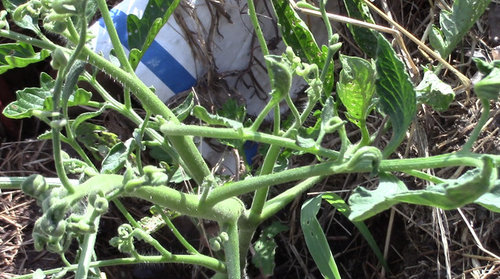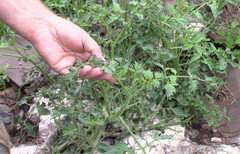Severe deformation of tomato foliage
Macmex
6 years ago
last modified: 6 years ago
Featured Answer
Sort by:Oldest
Comments (59)
Macmex
6 years agoAmyinOwasso/zone 6b
6 years agoRelated Discussions
Deformed/Curling leaves. Pics. (Unfinished Manure)
Comments (13)After hitting "Preview", I realized this post is LONG! Before you guys read enough to judge my intelligence and stop, I would like to thank all those that offered advice on this issue. Even if I don't quite show it, please don't think I don't value the experience I see here. In researching 2-4D, I found that it had a halflife of 10 days. I picked up the manure on Jan 31. Some of it was aged, some, not so much. Although the age is irrelevant as the manure may have become exposed to the herbicide after being... well, abandoned by the horse. Either way, whatever the concentration, it should have been at half strength on Feb 10, quarter strength on Feb 20, 1/8 strength on Mar 2, and 1/16 on Mar 12. Plants were planted on March 6. In looking at the docs provided by Jean, my plants appear to be much worse than the worst case scenario provided by the studies they did. However, with that said, it may not be 2-4D either, but something else that is more persistent. Or, there is the possibility that my neighbor sprayed something that I'm not aware of, possibly in his front yard (these are on the end of the bed closest to the front of the house...). Still, I would think that if this were drift, it would have affected more than just these four plants and the difference between plants four and 5 wouldn't be so evident. Either way, if it was the manure, and I believe we all agree that it is, I may still be OK. I don't care about these plants. There is nothing I can do about them anyway. Even if I were to pull them, I would have to put something else in their place and unless I dig out that whole end of the yard, I'd be putting new plants in the same position as the ones I'd be pulling. Besides, I'm in Texas. It's too late to be setting out. I've never put anything out this late and had it produce anything. The plants are going to have to die, grow out of it, or sit there and pout in a permanent prepubescent state. I had plants that had this issue last year on the other end of the same bed. They grew out of it just fine and ended up producing as well as anything else in my garden (it was not a good year). In the mean time, I'll keep soaking these plants to see if I can dilute down whatever is in the soil to levels were they are not longer an issue. If the plants die, the plants die. I have about 21 more. Like I said, these are experimentals anyway. Finally, I agree that this looks exactly like herbicide damage, and if you guys have not heard of anything other than herbicide that could cause this problem from horse manure, then we'll agree that this is herbicide damage. The main thing I was worried about was my compost pile. I used half the manure I retrieved that day on the spots these plants are now mixed the other half into my compost pile. The compost is about a year's worth and is finally finished. I used all I could this year and thought some manure and leaves now and coffee grounds through the year might keep it young and vibrant to be used for next year. While I'm sure it will be safe when next year's plants hit it in Feb-March of next year, I'll be sure to add some more materials to dilute any herbicide residuals that may persist. I was very worried that I was going to lose my compost pile (how sad is that?) The plants took 3 months to grow. I work on my compost piles year round!...See MoreSeveral Unrelated Questions (well, all are tomato related)
Comments (8)I can share a sure-fire solution to your irrigation problems. Years ago someone here accused me of being a dealer and having an ulterior motive behind recommending this little system. I sold hundreds of these but, I installed them. Never in all my years before retiring did I sell just the equipment. We installed irrigation systems. But, I'm now retired and cannot be accused of WORK anymore. At first, the stuff seems sorta Mickey-Mouse simple. Well, it's this simplicity that is what I think makes it work so well, for so many years. You start with 1/2-inch or 3/4-inch black poly tubing. One end connects to your spigot, the other end is "kinked off". Then you plug 1/4-inch spaghetti tubing into the larger tubing wherever you want to water a plant. At the ends of the spaghetti tubing you can choose from a multitude of "spray heads" to "emitters". I like emitters mainly for the very small volume of water they use and, because they don't water all-over the garden. They provide water right at the root zone and, deprive water to weeds. I use 2 emitters for a large plant like tomatoes. One of the heads that actually sprays outward in an "umbrella pattern" is called a "spectrum". It comes on either a 5-inch stake or, can be mounted higher. The spectrum types do wet the foliage though. There are some of these little systems still working fine, that I installed 25 years ago! I never had a customer who after using this "micro" system, had me remove it, not one. I have replaced hundreds of soaker hoses though. Check out Drip Works. I'm in Louisiana, they're in California, no connection. Our municipal water contains lots of calcium from the lime they add to the Mississippi River water we drink. This calcium plugs-up soaker hose rapidly, to the point where only a few spots emit water and everything else goes dry....See MoreYour most foliage disease-tolerant tomato plants?
Comments (32)Anney, I'm not critiquing, just want to be clear that foliage disease tolerance is VERY low in virtually all commercial tomatoes. There is one exception and that is for Early Blight. WV700 is an old commercial line that somehow wound up with a gene that gives relatively good tolerance to infection. This gene made its way into several other varieties over the years. It is probably the gene that Eva Purple Ball has which gives good disease tolerance. There are two mistakes to avoid; to think that a plant with low fruit load is somehow resistant, and to think that a vigorously growing plant is resistant. Low fruit load can easily result in reduced foliage damage. A plant that grows fast enough can produce new leaves faster than old leaves are destroyed with the caveat that it has to have the soil nutrients, sunshine, etc to maintain the growth. So long as you are selecting varieties that measure up for production, you can indeed make some interesting observations. Keith Mueller crossed Big Beef X Eva Purple Ball for me a few years ago. I've been growing out and stabilizing the resulting cross for a few years now and have a significantly more disease tolerant line than either parent. It stands up much better to nematodes than Eva Purple Ball and it handles foliage disease better than Big Beef. Production is phenomenally heavy though I have to say that flavor is still mediocre. I'd like to incorporate Late Blight tolerance into it and have sent Randy Gardner some seed hoping he can make a cross this year. Septoria is a sticky problem. There are exactly 2 lines in TGRC that have noted Septoria tolerance. I'm going to get both of them out for next season. I have not seen any tolerance in any variety that I have grown so far. DarJones...See MoreWhat's in YOUR tomato?: soil and foliage amendments
Comments (14)After a day of shoveling composted cow manure from the back of my truck that so over-loaded it that I almost left my own contribution inside the cab when it was so light in the front end as to be virtually unsteerable for a 30 mile drive, I came inside for a well needed break and found some excellent, well thought out contributions and then the previous one. WELLLL...EXCUUUUUUUUUse ME!!! So much for a sense of humor. Truth be told, I would LOVE to import some of the two feet of beautiful, black topsoil I saw when I attended a seminar among the Amish up in Illinois. Some of you might want to try to garden in this lovely red clay. They don't make bricks out of it for nothing. Exactly why after many years of tilling, I am finally going to above ground raised beds and also a few hay bale cold frames. Too, I think it a shame that where there are alternatives and good soil, some "respectable" retailers, rather than offering constructive cosultation and suggestions are NOT above selling miracle dust and pseudo science...as in the one seminar I attended where "scientists" were trying to set up a sales network for granite dust that may in a few thousand years be broken down and usable...for sale at a huge price but totally unwilling to say what it really was. Just because something is organic or natural doesn't mean it is viable or even helpful. Elsewhere, I HAVE had others say that most flavor comes from the life in the soil or the amendments, but like others here, I think that flavor, life in the soil, soil composition and amendments all work together as there is a LOT that we still don't know. Exactly why I was interested in finding what you have done and used that DOES work whether for disease, flavor or just healthy plants. FORTUNATELY, in just one week I have had some exchanges, sharing, and swaps here that have netted many a friend already....See MoreMacmex
6 years agoOkiedawn OK Zone 7
6 years agooldbusy1
6 years agoOkiedawn OK Zone 7
6 years agomilesdevin
6 years agoMacmex
6 years agoauthereray
6 years agomil_533
6 years agoMacmex
6 years agojerrydaniel87
6 years agolast modified: 6 years agonowyousedum
6 years agomil_533
6 years agonowyousedum
6 years agoOkiedawn OK Zone 7
6 years agoMacmex
6 years agoAmyinOwasso/zone 6b
6 years agoMacmex
6 years agolast modified: 6 years agoauthereray
6 years agojerrydaniel87
6 years agolast modified: 6 years agoAmyinOwasso/zone 6b
6 years agookoutdrsman
6 years agomil_533
6 years agoAmyinOwasso/zone 6b
6 years agoMacmex
6 years agoAmyinOwasso/zone 6b
6 years agoauthereray
6 years agookoutdrsman
6 years agoMacmex
6 years agoauthereray
6 years agoMacmex
6 years agoOkiedawn OK Zone 7
6 years agoMacmex
6 years agoAmyinOwasso/zone 6b
6 years agoOkiedawn OK Zone 7
6 years agoMacmex
6 years agochickencoupe
6 years agoOkiedawn OK Zone 7
6 years agoauthereray
6 years agoelkwc
6 years agoelkwc
6 years agoOkiedawn OK Zone 7
6 years agoelkwc
6 years agoAmyinOwasso/zone 6b
6 years agoelkwc
6 years agoAmyinOwasso/zone 6b
6 years agoOkiedawn OK Zone 7
6 years agoAmyinOwasso/zone 6b
6 years ago
Related Stories

SUMMER FRUITS AND VEGETABLESCherry Tomato Plant Does Double Duty as a Design Element
Besides being tasty, cherry tomatoes bring a burst of bright color to the landscape
Full Story
EDIBLE GARDENSSummer Crops: How to Grow Tomatoes
Plant tomato seedlings in spring for one of the best tastes of summer, fresh from your backyard
Full Story
GARDENING GUIDESBeautiful Flowers and Foliage From Dedicated Backyard Gardeners
From lawn daisies to topiaries, Houzz users share their backyard beauties
Full Story
GARDENING GUIDESCalifornia Gardener's June Checklist
Update your hydrangeas, catch up on tomatoes and more ways to enjoy your California garden in June
Full Story
THE ART OF ARCHITECTUREWorld of Design: Trees Bring Nature to a High-Rise in Milan
Discover ‘the most beautiful and innovative skyscraper in the world’ — the foliage-filled Bosco Verticale — and tour one of its apartments
Full Story
SUMMER GARDENINGHow to Grow Basil
Bright color, quick growth and endless uses for cooking make this summer annual a winner in the garden or a pot
Full Story
GARDENING GUIDESGreat Design Plant: Comptonia Peregrina
Though not a fern, sweet fern sure smells sweet and thrives in tough spots where many shrubs and ferns cannot
Full Story
EDIBLE GARDENS7 Edible, Pretty Wonders of the Plant World
It's OK to like them just for their looks, but these flowers, trees and greens have a tasty side too
Full Story
SPRING GARDENINGSummer Crops: How to Grow Strawberries
Pluck your own sweet strawberries right from the garden vine for smoothies, salads or eating then and there
Full Story
EDIBLE GARDENSHow to Add an Apple Tree to Your Edible Garden
Readily available, beautiful and fragrant, apple trees offer four-season interest along with crisp, juicy fruit
Full Story




Okiedawn OK Zone 7